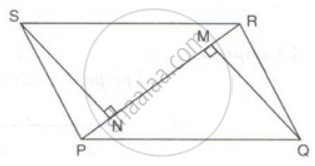Advertisements
Advertisements
प्रश्न
SN and QM are perpendiculars to the diagonal PR of parallelogram PQRS.
Prove that:
(i) ΔSNR ≅ ΔQMP
(ii) SN = QM
उत्तर
(i) In ΔSNR and ΔQMP
∠SNR = ∠QMP ...(right angles)
∠SRN = ∠MPQ ...(alternate angles since PQ || SR0
∴ ΔSNR ∼ ΔQMP
∠RSN = ∠PQM .........(i)
In ΔSNR and ΔQMP
∠SRN = ∠MPQ
∠RSN = ∠PQM ...(from (i))
PQ = SR ...(PQRS is a parallelogram)
Therefore, ΔSNR ≅ ΔQMP ...(ASA axiom)
(ii) Since ΔSNR ≅ ΔQMP
Hence, SN = QM.
APPEARS IN
संबंधित प्रश्न
ABCD is a parallelogram. P and T are points on AB and DC respectively and AP = CT. Prove that PT and BD bisect each other.
ABCD is a quadrilateral P, Q, R and S are the mid-points of AB, BC, CD and AD. Prove that PQRS is a parallelogram.
PQRS is a parallelogram. T is the mid-point of RS and M is a point on the diagonal PR such that MR = `(1)/(4)"PR"`. TM is joined and extended to cut QR at N. Prove that QN = RN.
In a parallelogram PQRS, M and N are the midpoints of the opposite sides PQ and RS respectively. Prove that
RN and RM trisect QS.
ABCD is a trapezium in which side AB is parallel to side DC. P is the mid-point of side AD. IF Q is a point on the Side BC such that the segment PQ is parallel to DC, prove that PQ = `(1)/(2)("AB" + "DC")`.
In the given figure, PQRS is a parallelogram in which PA = AB = Prove that: SA ‖ QB and SA = QB.
Prove that the diagonals of a square are equal and perpendicular to each other.
The diagonals AC and BC of a quadrilateral ABCD intersect at O. Prove that if BO = OD, then areas of ΔABC an ΔADC area equal.
In ΔABC, the mid-points of AB, BC and AC are P, Q and R respectively. Prove that BQRP is a parallelogram and that its area is half of ΔABC.
The medians QM and RN of ΔPQR intersect at O. Prove that: area of ΔROQ = area of quadrilateral PMON.
